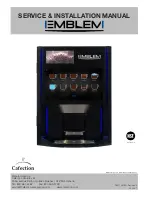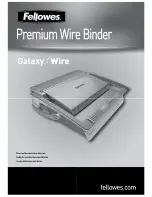
37
KX-FP365CX / KX-FM388CX
6.6.
Modem Section
6.6.1.
Function
The unit uses a 1 chip modem (IC5) that serves as an interface between the control section for FAX transmission and reception
and the telephone line. During a transmitting operation, the digital image signals are modulated and sent to the telephone line.
During a receiving operation, the analogue image signals which are received via the telephone line are demodulated and con-
verted into digital image signals. The communication format and procedures for FAX communication are standardized by ITU-T.
This 1 chip modem (IC5) has hardware which sends and detects all of the necessary signals for FAX communication.
It can be controlled by writing commands from the CPU (IC1: inside ASIC) to the register in the modem (IC5).
This modem (IC5) also sends DTMF signals, and detects a busy tone and dial tones.
Overview of Facsimile Communication Procedures (ITU-T Recommendation):
1. ON CCITT (International Telegraph and Telephone Consultative Committee)
The No. XIV Group of ITU-T, one of the four permanent organizations of the International Telecommunications Union (ITU),
investigates and make recommendations on international standards for facsimiles.
2. Definition of Each Group
• Group I (G1)
Official A-4 size documents without using formats which reduce the band width of a signal are sent over telephone lines.Deter-
mined in 1968.
Transmission for about 6 minutes at a scanning line density of 3.85 lines/mm.
• Group II (G2)
Using reduction technology in the modulation/demodulation format, an A-4 size document is sent at an official scanning line den-
sity of 3.85 lines/mm for about 3 minutes.
Methods to suppress redundancy are not used.
Determined in 1976.
• Group III (G3)
Method of suppressing redundancy in the image signal prior to modulation is used. An A-4 size document is sent within about
one minute.
Determined in 1980.
• Group IV (G4)
Transmission is via the data network. A method is provided for suppressing redundancy in signals prior to transmission, and
error-free reception of transmission is possible.
The scope of these facsimile applications is not limited simply to transmission of written statements. Through symbiotic linkages
with other communication methods, it can be expected to expand to include integrated services.
Summary of Contents for KX-FM388CX
Page 12: ...12 KX FP365CX KX FM388CX 6 Technical Descriptions 6 1 Connection Diagram ...
Page 14: ...14 KX FP365CX KX FM388CX 6 2 1 General Block Diagram ...
Page 16: ...16 KX FP365CX KX FM388CX 6 3 2 Memory Map ...
Page 25: ...25 KX FP365CX KX FM388CX 6 4 2 Block Diagram ...
Page 27: ...27 KX FP365CX KX FM388CX ...
Page 78: ...78 KX FP365CX KX FM388CX Countermeasure ...
Page 79: ...79 KX FP365CX KX FM388CX REFERENCE Test Mode P 63 ...
Page 80: ...80 KX FP365CX KX FM388CX REFERENCE Test Mode P 63 ...
Page 81: ...81 KX FP365CX KX FM388CX REFERENCE Test Mode P 63 ...
Page 82: ...82 KX FP365CX KX FM388CX REFERENCE Test Mode P 63 ...
Page 83: ...83 KX FP365CX KX FM388CX ...
Page 84: ...84 KX FP365CX KX FM388CX ...
Page 85: ...85 KX FP365CX KX FM388CX REFERENCE Test Mode P 63 ...
Page 89: ...89 KX FP365CX KX FM388CX ...
Page 114: ...114 KX FP365CX KX FM388CX ...
Page 121: ...121 KX FP365CX KX FM388CX I O and Pin No Diagram ...
Page 124: ...124 KX FP365CX KX FM388CX 12 5 5 2 NG Example ...
Page 130: ...130 KX FP365CX KX FM388CX 12 5 8 2 Troubleshooting Flow Chart ...
Page 136: ...136 KX FP365CX KX FM388CX 12 5 12 Thermal Head Section Note Refer to Thermal Head P 26 ...
Page 139: ...139 KX FP365CX KX FM388CX 13 Service Fixture Tools ...
Page 142: ...142 KX FP365CX KX FM388CX 14 1 2 How to Remove the Thermal Head ...
Page 144: ...144 KX FP365CX KX FM388CX 14 2 2 How to Remove the Pickup Roller ...
Page 145: ...145 KX FP365CX KX FM388CX 14 2 3 How to Remove the Paper Exit Roller and Cassette Lever ...
Page 146: ...146 KX FP365CX KX FM388CX 14 3 Lower Cabinet Section 14 3 1 How to Remove the Bottom Frame ...
Page 147: ...147 KX FP365CX KX FM388CX 14 3 2 How to Remove the Digital Analog Interface and Sensor Boards ...
Page 148: ...149 KX FP365CX KX FM388CX 14 3 4 How to Remove the Gear Block and Separation Roller ...
Page 149: ...148 KX FP365CX KX FM388CX 14 3 3 How to Remove the Power Supply Board and AC cord ...
Page 150: ...150 KX FP365CX KX FM388CX 14 3 5 How to Remove the Component parts of Gear Block ...
Page 153: ...153 KX FP365CX KX FM388CX 14 4 3 How to Remove the Separation Rubber ...
Page 154: ...154 KX FP365CX KX FM388CX 14 5 Installation Position of the Lead Wires ...
Page 155: ...155 KX FP365CX KX FM388CX ...
Page 168: ...168 KX FP365CX KX FM388CX 16 1 4 Power Supply Board 16 1 5 Interface Board ...
Page 170: ...170 KX FP365CX KX FM388CX 16 3 Test Chart 16 3 1 ITU T No 1 Test chart ...
Page 171: ...171 KX FP365CX KX FM388CX 16 3 2 ITU T No 2 Test Chart ...
Page 172: ...172 KX FP365CX KX FM388CX 16 3 3 Test Chart ...
Page 173: ...173 KX FP365CX KX FM388CX Memo ...
Page 194: ...194 KX FP365CX KX FM388CX 20 1 2 Operation Cover Section ...
Page 195: ...195 KX FP365CX KX FM388CX 20 1 3 Back Cover Section ...
Page 196: ...196 KX FP365CX KX FM388CX ...
Page 197: ...197 KX FP365CX KX FM388CX 20 1 4 Upper Cabinet Section ...
Page 198: ...198 KX FP365CX KX FM388CX 20 1 5 Lower Cabinet Section ...
Page 199: ...199 KX FP365CX KX FM388CX 20 1 6 Gear Block Section 20 1 7 Screws ...
Page 200: ...200 KX FP365CX KX FM388CX 20 1 8 Accessories and Packing Materials ...
















































